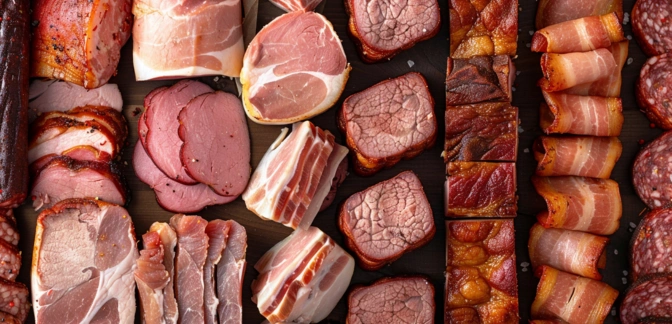Smoked Pork — Nutrients, Health Benefits, And Shopping Tips

Written by Listonic Team
Last update on September 4, 2024
Smoked pork nutrients
Nutrition facts
Amount per 100 g
Calories
🔥 417 kcal
| Nutrition per: 100 g | Value | % Daily Value* |
|---|---|---|
| Carbs | 0 g | - |
| Fiber | 0 g | - |
| Sugars | 0 g | - |
| Glycemic Index | 0 | - |
| Protein | 26 g | 52% |
| Sodium | 1500 mg | 65.22% |
| Total Fat | 34 g | 43.59% |
*The % of Daily Value (DV) tells you how much a nutrient in a serving of food contributes to a daily diet. 2,000 calories a day is used for general nutrition advice.
26 g
💪 High Protein Content
Smoked pork facts & tips
Health benefits
- Rich in protein, essential for muscle growth, repair, and overall body function.
- Contains essential vitamins and minerals such as B vitamins (especially B1, B6, and B12), iron, and zinc, which support energy production, immune function, and overall health.
- High in flavor, making it a tasty addition to meals, which can encourage the consumption of nutritious foods.
- Preservation of nutrients through smoking, making it a flavorful protein source.
Health risks
- High sodium content due to the smoking and curing process, which can contribute to hypertension and increased cardiovascular risks when consumed frequently.
- High fat content particularly in fatty cuts of smoked pork, which can raise cholesterol levels and increase the risk of heart disease.
- Potential for contamination with harmful substances such as nitrates and nitrites, used in the smoking process, which have been linked to an increased risk of cancer, particularly colorectal cancer.
- Risk of contamination with harmful bacteria or parasites, particularly if the smoked pork is not properly cooked or stored, leading to foodborne illness.
How to choose smoked pork
Smoked pork should exhibit a deep, consistent coloration from the smoking process and have a robust, smoky aroma. The meat should feel firm to the touch and be moist without being wet.
Do not buy smoked pork that has a dry or leathery texture, as it suggests it has been overcooked. Pork with an acrid smoke smell or mold on the surface should also be avoided, as these are signs of poor smoking practices or spoilage.

How to store smoked pork
Smoked pork should be stored in the refrigerator, wrapped tightly in plastic wrap or aluminum foil. Refrigeration maintains its flavor and freshness for up to a week. Keeping it properly sealed helps prevent it from drying out.
Exposure to air can cause smoked pork to lose its quality. Avoid leaving it uncovered, which can lead to spoilage. Always ensure the packaging is tightly sealed and check for any signs of off smells before consuming.
✅ Extra Tip
How long does it last?
Smoked pork can last for 1-2 weeks in the refrigerator. For longer storage, smoked pork can be frozen for up to 6 months.
What to do with leftovers?
Leftover smoked pork can be used in a variety of savory and hearty dishes. Slice it thinly and add to sandwiches, wraps, or sliders for a smoky, flavorful filling, or chop it up and mix into a stir-fry with vegetables and rice. Smoked pork is also great when added to pasta dishes with a tomato or barbecue sauce, or used as a topping for pizzas or flatbreads.
Use smoked pork in a stew or chili with beans, vegetables, and a rich broth, or mix it into a casserole with potatoes, cheese, and a creamy sauce. If you have a lot of smoked pork, consider making a batch of pulled pork sandwiches with coleslaw and pickles, or using it as a filling for tacos, burritos, or quesadillas. Smoked pork can also be sliced and served over a grain bowl with quinoa, roasted vegetables, and a tangy dressing. For a quick snack, reheat smoked pork slices and serve with a dipping sauce or on a bed of greens.
👨⚕️️ Medical disclaimer
Discover products from other categories
Listonic Team
Fact-checked
Our editorial team checked this article to make sure it was accurate at the time of publishing it.
Get the top-rated shopping list app

smoked pork
1 piece
Outline







